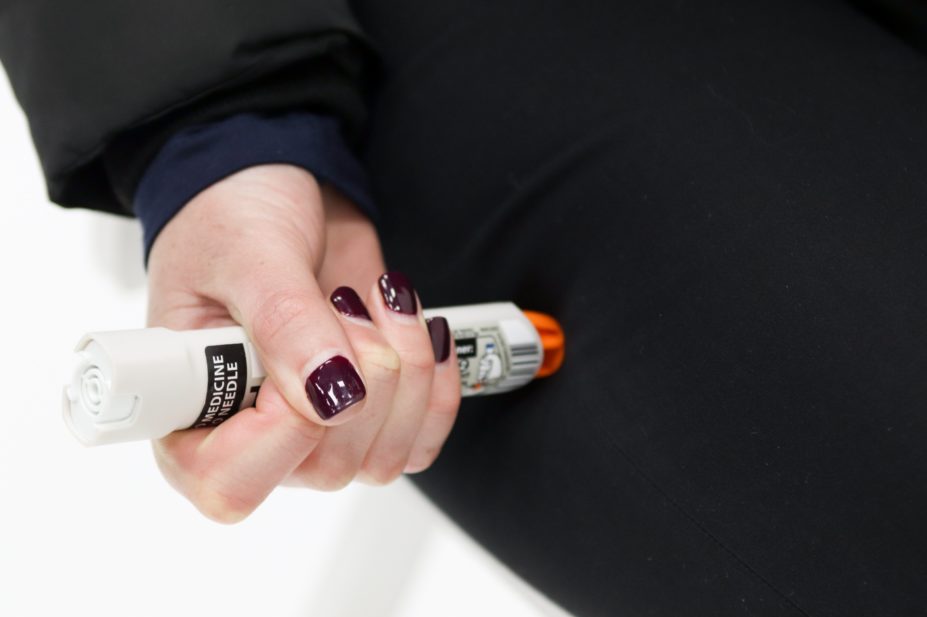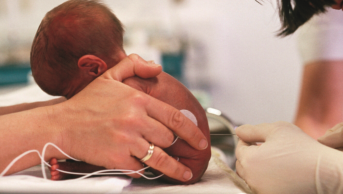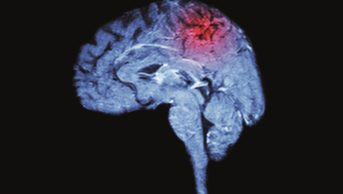
Shutterstock.com
Anaphylaxis is an acute, severe and potentially life-threatening systemic allergic reaction caused by the sudden release of mediators from mast cells and basophils[1]
. Triggers for anaphylactic reactions include foods (e.g. peanuts, fish, shellfish, cow’s milk, soy, eggs), natural rubber latex, medicines (e.g. general anaesthesia, penicillin) and insect stings (e.g. bee, wasp)[1]
.
The onset of the anaphylactic reaction generally occurs within seconds or minutes of exposure to the injected or ingested allergen, but the emergence of signs and symptoms varies between individuals. The skin, respiratory, circulatory and gastrointestinal systems can all be affected; however, the most serious signs and symptoms are reduced blood pressure, difficulty in breathing and loss of consciousness[1]
. For more information about recognising anaphylaxis, see ‘Anaphylaxis: symptoms, causes and diagnosis’.
Treatment options will depend on the patient’s location, and the equipment and drugs available. This article will outline different treatment options — with a focus on the use of adrenaline in patients with anaphylaxis — and prevention strategies.
Management in community pharmacy or primary care
Anaphylaxis requires an immediate intramuscular injection of adrenaline (epinephrine) into the middle of the outer thigh and can be given through clothing (see below). Adrenaline acts quickly to constrict blood vessels to normalise blood pressure, relax smooth muscles in the lungs to improve breathing, stimulate the heartbeat and help to stop angioedema. Delays in administration of adrenaline result in more serious, severe reactions and even fatal anaphylaxis[2]
.
An ambulance should be called immediately after adrenaline has been administered, even if symptoms start to improve, with the ambulance team informed that the patient is having an anaphylactic reaction.
If the patient has a suboptimal response to adrenaline or if their symptoms progress, a repeat dose of adrenaline is recommended after 5 to 15 minutes[3]
.
Emergency administration of adrenaline in the pharmacy
While there are restrictions that control the supply and administration of medicines, these do not apply to intramuscular administration of up to 1mg/mL of adrenaline for the emergency treatment of anaphylaxis[4]
. Regulation 238 of the Human Medicines Regulations 2012 allows anyone to administer adrenaline that is either prescribed for a specific person or to an unknown person for the purpose of saving a life in an emergency[5]
.
Therefore, when a patient has anaphylaxis, pharmacists should follow the steps outlined above, but should also regularly check their pharmacies have in-date adrenaline auto-injectors in stock that can be used in an emergency.
Community pharmacists commissioned to provide services where anaphylaxis treatment may be required, including, but not exclusive to, the flu vaccination service, should have an anaphylaxis pack in the pharmacy. This usually contains two ampoules of adrenaline 1:1000 (1mg/1mL), four 23G needles, four graduated 1mL syringes, and resuscitation masks suitable for children and adults. The Green Book states that auto-injectors for self-administration of adrenaline should not be used as a substitute for a proper anaphylaxis pack[6]
. Pharmacists must have the competency to draw up and administer adrenaline from ampoules with a syringe and needle; however, if only an adrenaline auto-injector is available, this should be used instead.
Adrenaline dose
The adrenaline dose delivered by an auto-injector device is weight-related and product specific[1]
. Patients who weigh more than 60kg can be given 500micrograms (0.5mL of the 1mg/mL solution or the 500microgram auto-injector [Bausch & Lomb UK Limited]). Pharmacists need to be aware of the recent supply issues (see Shortages and recalls) and understand their role in substituting products based on MHRA recommendations, such as replacing the 500 microgram dose of Emerade with other 300 microgram autoinjectors (e.g. Jext or Epi-pen; see bit.ly/MHRA-recall).
It is important to ensure that the correct product is dispensed for children who are prescribed adrenaline auto-injectors and that the dosing is based on the child’s weight as per the manufacturer’s marketing authorisation (see Table 1)[7],[8],[9]
. The British National Formulary for Children indicates that the lower weight band dosing for a junior strength auto-injector is 15kg. However, for infants who weigh less than 15kg who are at risk of anaphylaxis owing to accidental exposure, specialists recommend the junior strength auto-injector (150micrograms adrenaline) from the age of six months[10]
. For infants younger than this, avoidance of known triggers should be possible owing to limited dietary and environmental allergen exposure[10]
.
| Table 1: Auto-injector preparation for variations in children’s weight | |||||
|---|---|---|---|---|---|
| Product name and manufacturer* | Weight (kg) | ||||
| 7.5–25kg | <15kg | >25kg | 15–30kg | >30kg | |
| Emerade (Bausch & Lomb UK Limited) | n/a | Medical supervision only | n/a | 150micrograms | 300micrograms (adult dose) |
| EpiPen (epinephrine; Mylan) | 150micrograms (0.15mg) (EpiPenJr) | n/a | 300 micrograms (0.3mg; adult dose) | n/a | n/a |
| Jext (ALK-Abello Ltd) | n/a | Medical supervision only | n/a | 150micrograms | 300 micrograms (adult dose) |
| Sources: Summary of product characteristics for Emerade, EpiPen, Jext[7],[8],[9] . *Pharmacists should be aware of MHRA alerts that indicate a recent product recall of Emerade (see bit.ly/MHRA-recall) | |||||
Adrenaline administration
An intramuscular adrenaline injection should be administered to the anterolateral aspect of the middle-third of the outer thigh. There are no absolute contraindications to the administration of an adrenaline auto-injector during an allergic emergency.
Up to 20% of patients with anaphylaxis will experience a biphasic reaction — an initial reaction followed by a second reaction[11]
. The reported time to onset of the second reaction ranges from 1 to 78 hours; however, most occur within 8 hours. Therefore, it is important to ensure that patients and carers know to call for an ambulance as soon as adrenaline has been administered.
Three brands of adrenaline auto-injectors are available, and as the injection technique and method of administration varies between them, each device requires specific training (see Table 2)[7],[8],[9]
.
| Table 2: Licensed auto-injectors and their method of administration | |||||
|---|---|---|---|---|---|
| Product name and manufacturer* | Method of administration | ||||
| Emerade (Bausch & Lomb UK Limited) 150micrograms, solution for injection in pre-filled pen |
| ||||
| Emerade 300micrograms, solution for injection in pre-filled pen | |||||
| Emerade 500micrograms, solution for injection in pre-filled pen | |||||
| EpiPen (Mylan) adrenaline (epinephrine) auto-injector 0.3mg |
| ||||
| EpiPen Jr. Adrenaline (epinephrine) auto-injector 0.15mg | |||||
| Jext (ALK Abello Ltd) 150micrograms solution for injection in pre-filled pen |
| ||||
|
Sources: Summary of product characteristics for Emerade, EpiPen, Jext7,8,9 | |||||
Management of the patient in the pharmacy
Patients having an anaphylactic reaction should be recognised and treated using the Airway, Breathing, Circulation, Disability, Exposure (ABCDE) approach[12]
. Correct positioning of the patient is important in anaphylaxis[12]
. Case studies have highlighted the potential for a change in position (e.g. from sitting or lying to standing) to trigger decompensation and fatal events in some patients. If the patient has circulation problems, lying the patient supine with the lower limbs elevated will increase venous return and cardiac output[13]
. Patients with respiratory symptoms can be allowed to sit if this improves comfort, with their lower limbs elevated where possible; however, sudden standing must be avoided[13]
.
Management in hospital
The use of intravenous (IV) adrenaline is hazardous — there is a much greater risk of causing harmful side effects by inappropriate dosage or misdiagnosis of anaphylaxis when using IV adrenaline, compared with administration via an auto-injector.[14]
. Therefore, it should only be considered in patients with profound shock that is immediately life-threatening and initiated by healthcare professionals who are experienced in its use[15]
. For example, in cases where a patient is severely ill and there is doubt about the adequacy of the circulation and absorption of adrenaline after intramuscular injection, adrenaline can also be given by slow IV injection and repeated according to response[16]
. However, where intramuscular injection might still succeed, time should not be wasted seeking IV access[16]
.
Oxygen
The highest concentration of oxygen should be given using a mask with an oxygen reservoir. To prevent collapse of the reservoir during inspiration, high-flow oxygen should be given (greater than 10L/min)[1]
.
Fluid management
Large volumes of fluid may leak from the patient’s circulation during an anaphylactic reaction, with signs of vasodilation, hypotension and shock. Fluids should be given to the patient as soon as available. If there is intravenous access, fluid infusion should start immediately[1]
.
Antihistamines (after initial resuscitation)
As a potential treatment for an anaphylactic reaction, the evidence to support the use of antihistamines is weak[17]
. A Cochrane review concluded that there is no evidence from randomised controlled trials to support the use of H1-antihistamines (e.g. chlorpheniramine, diphenhydramine, hydroxyzine and promethazine) in the emergency management of anaphylaxis[17]
. However, antihistamines may help counter histamine-mediated vasodilation and bronchoconstriction to relieve symptoms after initial resuscitation. Chlorphenamine is recommended to be injected slowly intravenously or intramuscularly[18]
.
Shortages and recalls
Supply issues and recalls affecting some brands of adrenaline auto-injectors on the UK market were announced in April and May 2020
[19],[20]
. Pharmacists should monitor stock levels and ensure they track shortage notifications (e.g. the Medicines and Healthcare products Regulatory Agency [MHRA] alert for Emerade auto-injectors). If a patient is switched to an alternative device, it is essential to ensure patients are able to use their new device correctly.
Prevention
1. Avoid triggers
Once a patient has experienced anaphylaxis, they are at higher risk of experiencing it again. It is, therefore, important to identify the trigger for the reaction and how to avoid it in the future (e.g. a patient with an allergy to a medicine should have this recorded on their medical notes and wear a medical alert bracelet/necklace)[21]
.
2. Referral to a specialist allergy service
After emergency treatment for suspected anaphylaxis, patients should be referred to an allergist for diagnosis of the aetiology and its management, although NHS allergy services within the UK vary[10]
. Patients with severe reactions (e.g. a suspected drug-induced reaction, venom anaphylaxis and where multiple foods are implicated) should be referred for specialist input[4]
. Management will include allergen avoidance advice and a written treatment plan with education and training. Patients with concurrent asthma will also need an assessment to optimise management[10]
.
3. Auto-injector device training
Studies have shown that only between a third and half of patients are able to demonstrate the correct technique for using their adrenaline auto-injector devices, which constitutes a major risk[10]
. Pharmacists can educate patients and their carers, and confirm correct technique and offer device training when dispensing adrenaline auto-injector devices[10]
.
4. Carry two auto-injectors
In 2017, the MHRA issued guidance stating that individuals at risk of anaphylaxis should always carry two adrenaline auto-injectors because “uncertainties about the site of drug delivery and the speed of adrenaline action within the body”, as well as the risk of device misuse or malfunction, may result in a second dose being needed[22]
. Manufacturers also recommend that two adrenaline auto-injector pens should be carried at all times[7],[8],[9]
. Carrying two devices does not replace allergen avoidance, education or training; in addition, thorough risk assessments completed by the patient’s specialist clinician can help determine the number of adrenaline auto-injectors that need to be prescribed[22]
.
5. Store the auto-injectors correctly
Extremes of temperature can make adrenaline less effective; therefore, auto-injectors should be stored as per the summary of product characteristics (e.g. do not refrigerate or freeze an auto-injector). It is important to also check the expiry date regularly as the shelf life between brands can vary[6],[7],[8]
.
6. Have spare auto-injectors in schools
As well as having access to an adrenaline auto-injector on the journey to and from school, children may need to be prescribed additional adrenaline auto-injectors for use in an emergency during school hours; therefore, an adrenaline auto-injector should be stored on the school premises during term time.
Schools can also purchase spare pens for pupils (e.g. in case the pupil’s own adrenaline auto-injector has been administered incorrectly, misfired or is unavailable) without a prescription from pharmaceutical suppliers (e.g. local pharmacies, using a letter template available online)[23]
. The Department of Health and Social Care advises that schools should obtain the same brand as the pupil’s auto-injector[23]
. However, if two or more brands of adrenaline auto-injectors are used by pupils, schools can purchase the most commonly prescribed brand to be used as the spare pen[24]
. Owing to the operating differences of each adrenaline auto-injector, face-to-face training on each device should be provided to school staff for emergency administration[24],[25]
. Annual anaphylaxis training and demonstrations with trainer pens for school staff can be offered by approved first aid training providers or public health and community school nursing teams. This training can be supplemented with Schools Allergy Awareness Resource Packs and AllergyWise for Schools online training available from the Anaphylaxis Campaign[26]
.
Best practice
There are a range of key messages pharmacists should emphasise to patients when dispensing their adrenaline auto-injector prescription:
- Ensure patients and/or carers know:
- How to use the adrenaline auto-injector;
- Pharmacists and healthcare professionals can order trainer pens and videos from the manufacturer’s website for demonstration;
- How to store their adrenaline auto-injectors and protect the device from excessive heat or cold;
- How to dispose of used adrenaline auto-injectors according to the manufacturer’s guidelines;
- That they must keep two, in-date adrenaline auto-injectors with them at all times;
- That they should regularly check the window of their adrenaline auto-injector device to ensure the liquid is clear and colourless, and to get new devices if the solution turns brown or contains particles;
- That they can sign up to the expiry alert service for their adrenaline auto-injectors on the relevant manufacturer’s website[20],[21],[22]
.
Signpost patients and/or carers for further advice and information:
- The Anaphylaxis Campaign. Available at: www.anaphylaxis.org.uk and national helpline service (tel: 01252 542029, 09:00–17:00, Monday to Friday);
- Allergy Action Plan from the British Society for Allergy and Clinical Immunology/Royal College of Paediatrics and Child Health.
Pharmacists should also stay up to date with the current guidelines for managing anaphylaxis in an emergency[1],[10],[26]
.
Useful resources
- Anaphylaxis Campaign. Available at: www.anaphylaxis.org.uk
- British society for Allergy and Clinical Immunology. Available at: https://www.bsaci.org/
About the authors
Anna C Murphy is consultant respiratory pharmacist at University Hospitals of Leicester NHS Trust and pharmacy advisor at the Anaphylaxis Campaign; Danielle Johnson is information officer at the Anaphylaxis Campaign; and Beenal R Rajyaguru is specialist pharmacist at the University Hospitals of Leicester NHS Trust.
References
[1] Resuscitation Council UK. Emergency treatment of anaphylactic reactions: guidelines for healthcare providers. 2012. Available at: https://www.resus.org.uk/pages/reaction.pdf (accessed July 2020)
[2] Chooniedass R, Temple B & Becker A. Epinephrine use for anaphylaxis: too seldom, too late: current practices and guidelines in health care. Ann Allergy Asthma Immunol 2017;119:108–110. doi: 10.1016/j.anai.2017.06.004
[3] Medicines and Healthcare products Regulatory Agency. Adrenaline auto-injectors: advice on use. 2018. Available at: https://assets.publishing.service.gov.uk/media/5b644e25ed915d377695c83d/AAI-PDF-v4.pdf (accessed July 2020)
[4] Royal Pharmaceutical Society. Medicines, Ethics and Practice. Royal Pharmaceutical Society: London; 2019. p.124–125.
[5] UK Government. The Human Medicines Regulations 2012. Regulation 238. 2012. Available at www.legislation.gov.uk/uksi/2012/1916/regulation/238/made (accessed July 2020)
[6] Public Health England. Vaccine safety and the management of adverse events following immunisation: The Green Book, chapter 8. Available at: https://assets.publishing.service.gov.uk/government/uploads/system/uploads/attachment_data/file/147868/Green-Book-Chapter-8-v4_0.pdf (accessed July 2020)
[7] Electronic medicines compendium. Emerade, 500 micrograms, solution for injection in pre-filled pen. 2020. Available at: https://www.medicines.org.uk/emc/product/5279/smpc (accessed July 2020)
[8] Electronic medicines compendium. EpiPen Adrenaline (Epinephrine) Auto-Injector 0.3 mg. 2019. Available at https://www.medicines.org.uk/emc/product/4289/smpc (accessed July 2020)
[9] Electronic medicines compendium. Jext 300 micrograms solution for injection in pre-filled pen. 2019. Available at: https://www.medicines.org.uk/emc/product/5748/smpc (accessed July 2020)
[10] Ewan P, Brathwaite N, Leech S et al. Prescribing an adrenaline auto-injector. Clin Exp Allergy 2016;46(12):1621–1622. doi: 10.1111/cea.12855.11
[11] Stark BJ & Sullivan TJ. Biphasic and protracted anaphylaxis. J Allergy Clin Immunol 1986;78:76–83. doi: 10.1016/0091-6749(86)90117-x
[12] Resuscitation Council UK. The ABCDE approach. 2015. Available at: https://www.resus.org.uk/library/2015-resuscitation-guidelines/abcde-approach (accessed July 2020)
[13] Anagnostou K & Turner PJ. Myths, facts and controversies in the diagnosis and management of anaphylaxis. Arch Dis Child 2019;104(1):83–90. doi: 10.1136/archdischild-2018-314867
[14] Pumphrey RS. Lessons from the management of anaphylaxis from a study of fatal reactions. Clin Exp Allergy 2000;30(8):1144–1150. doi: 10.1046/j.1365-2222.2000.00864.x
[15] Johnston SL, Unsworth J & Gompels MM. Adrenaline given outside the context of life threatening allergic reactions. BMJ 2003;326(7389):589–590. doi: 10.1136/bmj.326.7389.589
[16] National Institute for Health and Care Excellence. Adrenaline/Epinephrine. 2020. Available at: https://bnf.nice.org.uk/drug/adrenalineepinephrine.html (accessed July 2020)
[17] Sheikh A, Ten Broek V, Brown SGA & Simons FER. H(1)-antihistamines for the treatment of anaphylaxis: Cochrane systematic review. Allergy 2007;62(8):830–837. doi: 10.1111/j.1398-9995.2007.01435.x
[18] Electronic medicines compendium. Chlorphenamine Maleate 10mg/ml Solution for Injection. 2017. Available at: https://www.medicines.org.uk/emc/product/1986 (accessed July 2020)
[19] Medicines and Healthcare products Regulatory Agency. Class 2 medicines recall: Emerade 500 micrograms solution for injection in pre-filled syringe, PL 33616/0015 (EL(20)A/23. 2020. Available at: https://www.gov.uk/drug-device-alerts/class-2-medicines-recall-emerade-500-micrograms-solution-for-injection-in-pre-filled-syringe-pl-33616-0015-el-20-a-23 (accessed July 2020)
[20] Medicines and Healthcare products Regulatory Agency. Class 2 medicines recall: Emerade 300 micrograms solution for injection in pre-filled syringe, PL 33616/0014 (EL(20)A/20). 2020. Available at: https://www.gov.uk/drug-device-alerts/class-2-medicines-recall-emerade-300-micrograms-solution-for-injection-in-pre-filled-syringe-pl-33616-0014-el-20-a-20 (accessed July 2020)
[21] American college of allergy, asthma and immunology. Anaphylaxis. 2018. Available at: https://acaai.org/allergies/anaphylaxis#:~:text=Avoid%20your%20trigger.,and%20access%20to%20medical%20care (accessed July 2020)
[22] Medicine and Healthcare products Regulatory Agency. Adrenaline auto-injectors: updated advice after European review. 2017. Available at https://www.gov.uk/drug-safety-update/adrenaline-auto-injectors-updated-advice-after-european-review (accessed July 2020)
[23] Department of Health and Social Care. Guidance on the use of adrenaline auto-injectors in schools. 2017. Available at: https://www.gov.uk/government/publications/using-emergency-adrenaline-auto-injectors-in-schools (accessed July 2020)
[24] Spare pens in schools. Supply, storage and care of adrenaline auto-injectors. 2019. Available at: https://www.sparepensinschools.uk/for-pharmacists/supply-storage-and-care-of-aais/ (accessed July 2020)
[25] Spare pens in schools. Staff training and school policies. 2019. Available at: https://www.sparepensinschools.uk/for-schools/staff-training-and-school-policies/ (accessed July 2020)
[26] Anaphylaxis Campaign. AllergyWise Online Training. 2019. Available at: https://www.anaphylaxis.org.uk/information-training/allergywise-training/ (accessed July 2020)


